AMD EPYC 7451 Test Configuration
By the end of September, had every AMD EPYC SKU tested on a common Tyan EPYC platform and work started on another platform. Here is the base hardware configuration we are using:
- CPU: AMD EPYC 7451
- Server Barebones: Tyan Transport SX TN70A-B8026 (B8026T70AE24HR)
- RAM: 8x 16GB 128GB DDR4-2666 RDIMMs (Samsung)
- SSD: 1x Intel DC S3710 400GB SATA SSD
- NIC: 1x Mellanox ConnectX-3 Pro

Key to this system is that it supports 24x NVMe U.2 NVMe SSDs without using Broadcom PLX PCIe expanders. That is 96 lanes of PCIe 3.0 directly from a single SKU. One of the key advantages AMD EPYC has is that a single EPYC CPU can use 128x PCIe lanes, the same number as the dual socket configuration. Tyan has responded to this opportunity by offering a single-socket system that can handle 24x NVMe drives plus have I/O available for 10/25/40/50/100GbE.

AMD and Tyan originally suggested that we use a Samsung SSD (as pictured), however, to aid in consistency, we are using our lab standard Intel DC S3710 400GB SSDs.
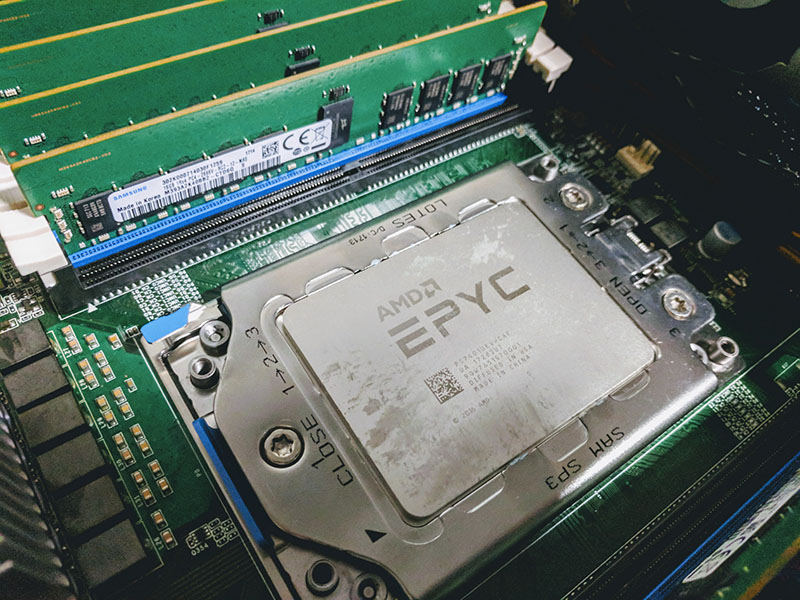
This is a great system that has worked well over the past several quarters. If you have an existing Intel Xeon E5 V1-V4 installation, it is likely that a single socket AMD EPYC 7000 series machine using NVMe drives can replace a dual socket or multiple dual socket previous generation servers. We have seen companies consolidate as many as four dual socket Intel Xeon E5-2620 V1 servers into a single AMD EPYC 7000 series server which is a great consolidation savings.
AMD EPYC 7451 Benchmarks
For this exercise, we are using our legacy Linux-Bench scripts which help us see cross-platform “least common denominator” results we have been using for years as well as several results from our updated Linux-Bench2 scripts. At this point, our benchmarking sessions take days to run and we are generating well over a thousand data points. We are also running workloads for software companies that want to see how their software works on the latest hardware. As a result, this is a small sample of the data we are collecting and can share publicly. Our position is always that we are happy to provide some free data but we also have services to let companies run their own workloads in our lab, such as with our DemoEval service. What we do provide is an extremely controlled environment where we know every step is exactly the same and each run is done in a real-world data center, not a test bench.
Python Linux 4.4.2 Kernel Compile Benchmark
This is one of the most requested benchmarks for STH over the past few years. The task was simple, we have a standard configuration file, the Linux 4.4.2 kernel from kernel.org, and make the standard auto-generated configuration utilizing every thread in the system. We are expressing results in terms of compiles per hour to make the results easier to read.

AMD typically does well in this type of workload so you can see that the performance is exceptional here. The extra clock speed puts the AMD EPYC 7451 just shy of the Intel Xeon Gold 6152 part that costs around 50% more in this test.
c-ray 1.1 Performance
We have been using c-ray for our performance testing for years now. It is a ray tracing benchmark that is extremely popular to show differences in processors under multi-threaded workloads. We are going to use our new Linux-Bench2 8K render since it teases out more differences in this CPU segment than our older 4K results.
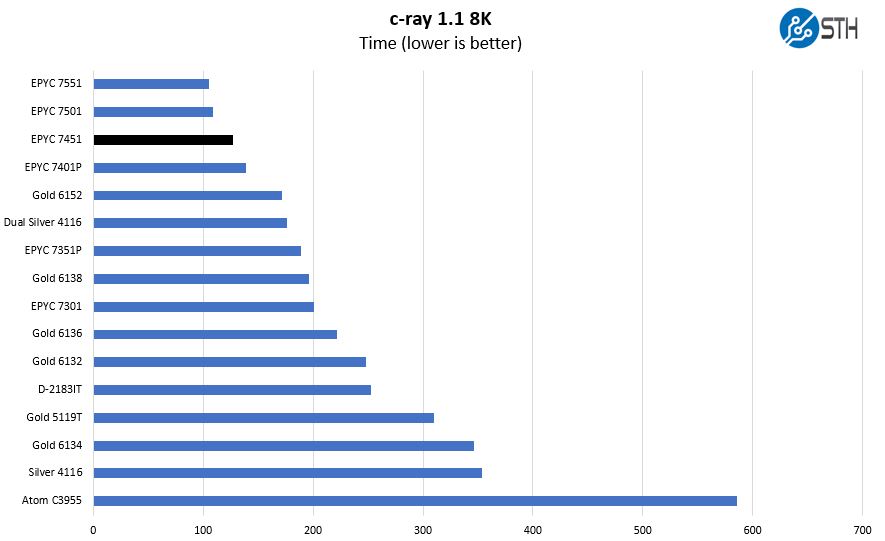
AMD typically does well in this type of workload so you can see that the performance is exceptional here. The reliance on low cache latency within the same NUMA node is one of the key reasons AMD pulls ahead across the board.
7-zip Compression Performance
7-zip is a widely used compression/ decompression program that works cross-platform. We started using the program during our early days with Windows testing. It is now part of Linux-Bench.

Here is an intriguing chart. If you are licensed on a per-socket basis, the single socket AMD EPYC 7451 shows a nice gain over the dual Intel Xeon Silver 4116 setup. The dual Intel Xeon setup costs about the same as a single AMD EPYC 7451 so software licensing (e.g. VMware licensing) can be a tie breaker.
NAMD Performance
NAMD is a molecular modeling benchmark developed by the Theoretical and Computational Biophysics Group in the Beckman Institute for Advanced Science and Technology at the University of Illinois at Urbana-Champaign. More information on the benchmark can be found here. We are going to augment this with GROMACS in the next-generation Linux-Bench in the near future. With GROMACS we have been working hard to support Intel’s Skylake AVX-512 and AVX2 supporting AMD Zen architecture. Here are the comparison results for the legacy data set:

Before we move to AVX-512 and GROMACS, you can see some great performance from AMD on our NAMD test. There is a lot of number crunching power available here.
Sysbench CPU test
Sysbench is another one of those widely used Linux benchmarks. We specifically are using the CPU test, not the OLTP test that we use for some storage testing.
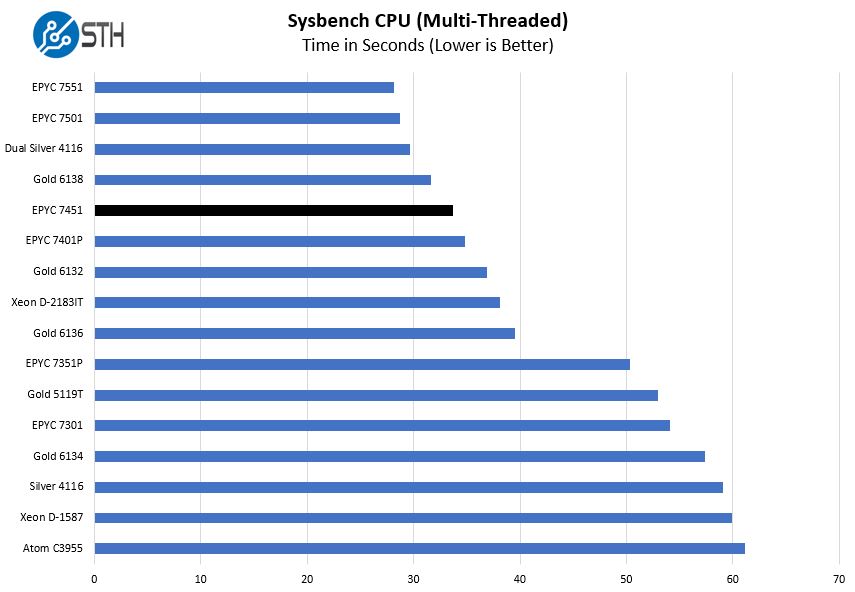
At this point, you have probably seen a pattern emerge. The AMD EPYC 7451 is slightly faster than the AMD EPYC 7401P. That AMD EPYC 7401P is a single socket only part that is immensely popular for its price/ performance ratio. We think most single socket server deployments will opt for the “P” variants, however, there are a number of servers installed with single CPUs only in dual socket servers so we wanted to show the entire line in a single socket context.
OpenSSL Performance
OpenSSL is widely used to secure communications between servers. This is an important protocol in many server stacks. We first look at our sign tests:
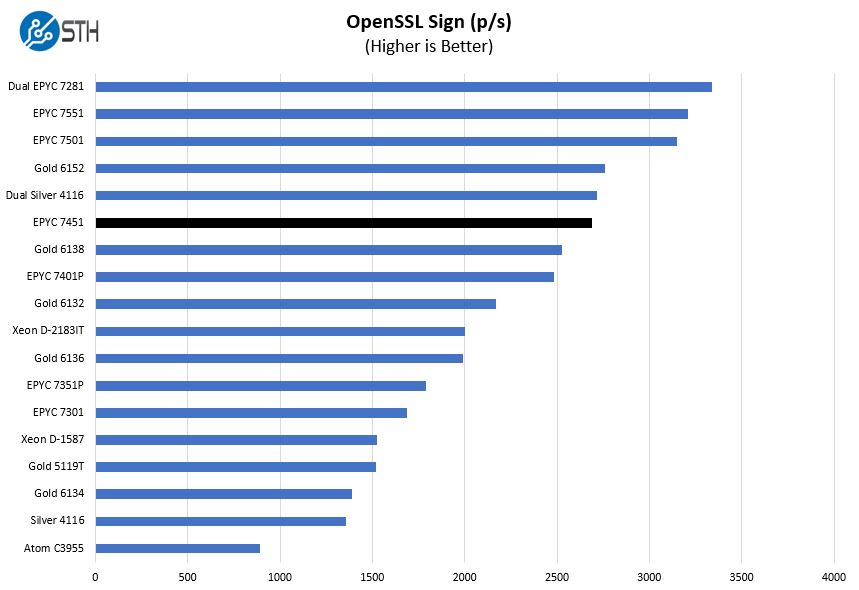
And the verify results:
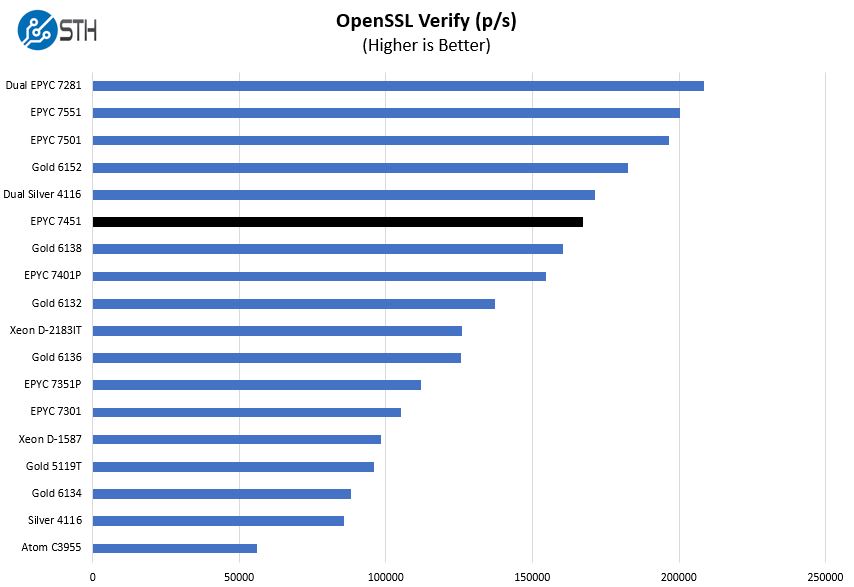
Here the single AMD EPYC 7451 and dual Intel Xeon Silver 4116 CPUs are very close on the performance chart. That again shows just how strong AMD’s single socket story is.
UnixBench Dhrystone 2 and Whetstone Benchmarks
Some of the longest-running tests at STH are the venerable UnixBench 5.1.3 Dhrystone 2 and Whetstone results. They are certainly aging, however, we constantly get requests for them, and many angry notes when we leave them out. UnixBench is widely used so we are including it in this data set. Here are the Dhrystone 2 results:
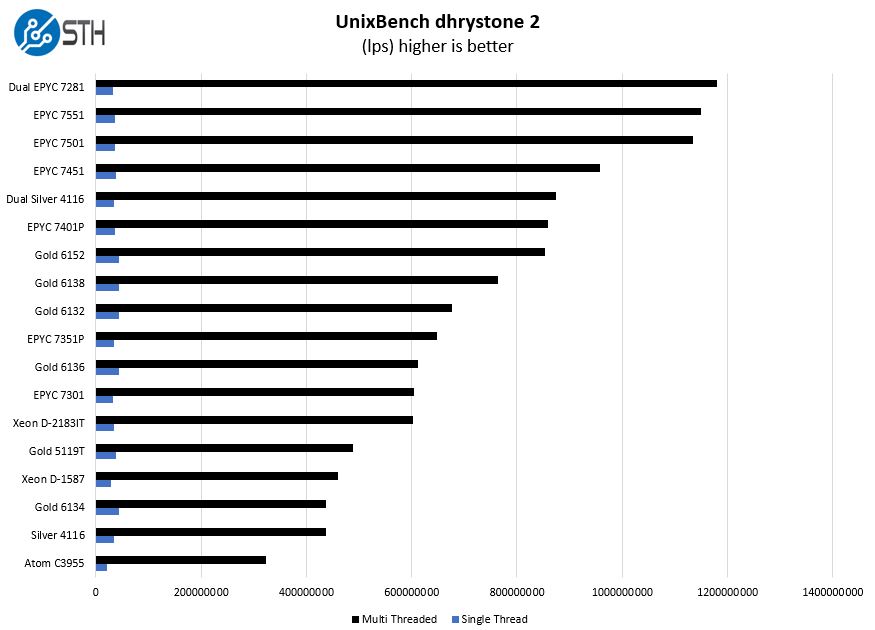
And the whetstone results:
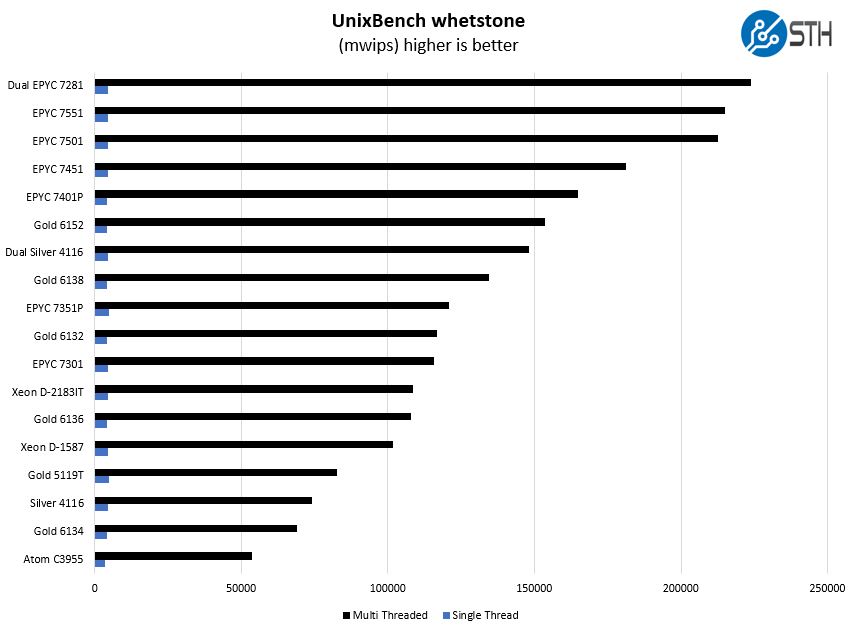
This is a trend we have seen for several AMD EPYC reviews thus far. Excellent performance across the board.
GROMACS STH Small AVX2/ AVX-512 Enabled
We have a small GROMACS molecule simulation we previewed in the first AMD EPYC 7601 Linux benchmarks piece. In Linux-Bench2 we are using a “small” test for single and dual socket capable machines. Our medium test is more appropriate for higher-end dual and quad socket machines. Our GROMACS test will use the AVX-512 and AVX2 extensions if available.

Here in the EPYC range, you can see the clear steps in core counts between the 16 core, 24 core and 32 core variants. AVX-512 helps dual port FMA Intel CPUs (Gold 6100 and Platinum 8100) perform extremely well here. On the other hand, Gold 5100 and Silver 4116 CPUs, even with AVX-512 cannot match the performance of the AMD EPYC CPUs.
Chess Benchmarking
Chess is an interesting use case since it has almost unlimited complexity. Over the years, we have received a number of requests to bring back chess benchmarking. We have been profiling systems and are ready to start sharing results:
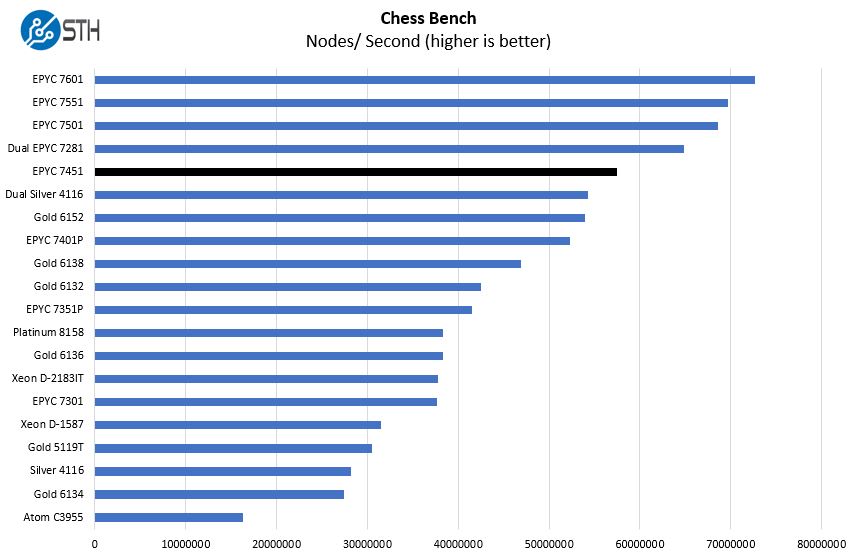
Here again, AMD’s single socket story bests dual socket Intel Xeon 4116 which cost about the same and single socket Intel Xeon Gold 6152 CPUs which costs 50% more. This is a great performance.
Next, we are going to look at power consumption, market positioning, and some of our final thoughts.

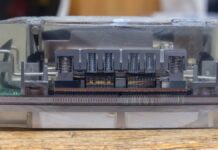


Great review. this Epyc’s doing truly epic work. The value’s incredible.
In future, could you please include the exact X-axis benchmark values in the bars though? Something like; https://i.imgur.com/TdL6UhR.png Just to have exact data and make it easier to compare instead of guesstimating based on the numbers at the bottom.
Cheers.
It would be great to get some FFMPEG benchmarks!